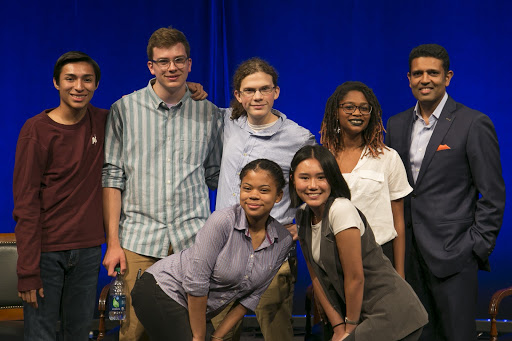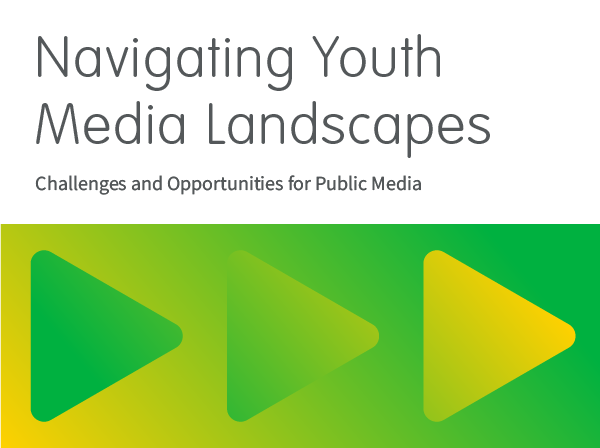
It seems like we’re having a lot of conversations about teens and tweens these days. Or youth? Young people? All of these terms get used by various disciplines, and some even get used by the young people themselves. However you talk about it, it’s clear that public media needs to be ready for the next generation of audiences (and technology)—because they’re already here.
Right now, we’re in the middle of a new research project called By/With/For Youth: Inspiring Next Gen Public Media Audiences. This project is a direct response to a desire expressed by a variety of public media stations to better understand the “missing audience” of young people who grow out of the educational and enriching media programs public media offers to younger children. Our research seeks to more deeply understand the current media habits of tweens and teens and to envision a future of public media that equips young people to participate and thrive in today’s complex world.
The first step of our process was to ask what we know about young people already, and what descriptions we find most valuable about the current youth media landscape. This meant referring to a wide range of research literature, from public media-commissioned studies to social science surveys and direct ethnographic work. We spoke with experts on youth engagement, media literacy, and connected learning (among others), to give us the best baseline for the core of our work: talking directly to a diverse set of young people to understand how they already use media, and how they think about the role of media in their lives. We are now speaking with youth across the country about how public media can best meet their needs in this consequential moment.
While our research continues, we’re sharing our initial review findings in Navigating Youth Media Landscapes: Challenges and Opportunities for Public Media to start a conversation and gather support for the larger public service we hope our work will inspire. Already, we’ve assembled material on the following questions:
- How does adolescent development intersect with current youth media practices?
- How do different youth relate to media in varying socioeconomic and cultural contexts?
- What motivates young people to engage with the media they choose, and how do those behaviors change as they age?
- At a broader level, what messages about youth are being transmitted (or omitted) by the media in general?
In order to answer these questions, we’ve identified the following key themes to be examined through fieldwork:
- Age Range/Participant Selection – identifying “youth” or “young people” will always produce a range of overlapping ages and identities
- Device/Access Profiles – because public media has an underlying mandate to universality, it is key to explore all forms of media consumption and access
- Social Goals – since youth are likely to use media to accomplish social (and other) goals, it will be important to find common motivations for media use
- Media Avoidance/Obfuscation – it will be important, yet challenging, to capture youth practices of media avoidance, or when and how they choose to obfuscate their media behaviors
- “Incidental” Media Access – it will be valuable to observe what types of media youth might be exposed to on algorithmically or socially curated platforms, media that might not be explicit parts of their intended activity
- Influencers and the Parasocial – we need to identify how youth discuss and conceptualize influencers and parasocial relationships to media
- Information Seeking/Education/How-To – with the pace of new platforms and trends in media use, it is always valuable to reassess how youth have learned to proactively seek the answers to questions or the sources of new skills
- Media Production – given the potential value of public media amplifying media made by youth, it bears observing how youth might be creating content in modes that are not currently identified. What behaviors and engagements with contemporary media are allowing youth to create, shape, or alter media messages?
With these themes as a basis, we’re following this initial research forward in several directions. On the one hand, it is crucial to identify what young people are already doing, how they are already meeting their needs with existing media, and whether new forms of public media are poised to meet them where they are. On the other hand, identifying the persistent gaps in how youth are underserved by the commercial media landscape could be another key to extending the underlying service mission of public media and break from the status quo. This is why the descriptive work that informs research design must be based on advancing core values, and efforts to increase audience numbers is always coupled with a firm commitment to improving communities and advancing universal service. As the national (and global) media ecosystem continues to converge, empirical research that centers the voices of youth in this way will help to ensure that the next generation of public media programming is responsive to their unique needs and experiences.
 Patrick Davison is the Program Manager for Research Production and Editorial at Data & Society Research Institute. He holds a PhD from NYU’s department of Media, Culture, and Communication, and his research is on the relationship between networked media and culture.
Patrick Davison is the Program Manager for Research Production and Editorial at Data & Society Research Institute. He holds a PhD from NYU’s department of Media, Culture, and Communication, and his research is on the relationship between networked media and culture.
 Monica Bulger is a Senior Fellow at the Joan Ganz Cooney Center at Sesame Workshop. She studies youth and family media literacy practices and advises policy globally. She has consulted on child online protection for UNICEF since 2012, and her research encompasses 16 countries in Asia, the Middle East, North Africa, South America, North America, and Europe. Monica is an affiliate of the Data & Society Research Institute in New York City where she led the Connected Learning initiative. Monica holds a PhD in Education and was a Research Fellow at the Oxford Internet Institute and the Berkman Klein Center for Internet & Society at Harvard University.
Monica Bulger is a Senior Fellow at the Joan Ganz Cooney Center at Sesame Workshop. She studies youth and family media literacy practices and advises policy globally. She has consulted on child online protection for UNICEF since 2012, and her research encompasses 16 countries in Asia, the Middle East, North Africa, South America, North America, and Europe. Monica is an affiliate of the Data & Society Research Institute in New York City where she led the Connected Learning initiative. Monica holds a PhD in Education and was a Research Fellow at the Oxford Internet Institute and the Berkman Klein Center for Internet & Society at Harvard University.
 Mary Madden is a veteran researcher, writer and nationally-recognized expert on privacy and technology, trends in social media use, and the impact of digital media on teens and parents. She is an Affiliate at the Data & Society Research Institute in New York City, where she most recently directed an initiative to explore the effects of data-centric systems on Americans’ health and well-being and led several studies examining the intersection of privacy and digital inequality. Prior to her role at Data & Society, Mary was a Senior Researcher for the Pew Research Center’s Internet, Science & Technology team in Washington, DC and an Affiliate at the Berkman Klein Center for Internet & Society at Harvard University.
Mary Madden is a veteran researcher, writer and nationally-recognized expert on privacy and technology, trends in social media use, and the impact of digital media on teens and parents. She is an Affiliate at the Data & Society Research Institute in New York City, where she most recently directed an initiative to explore the effects of data-centric systems on Americans’ health and well-being and led several studies examining the intersection of privacy and digital inequality. Prior to her role at Data & Society, Mary was a Senior Researcher for the Pew Research Center’s Internet, Science & Technology team in Washington, DC and an Affiliate at the Berkman Klein Center for Internet & Society at Harvard University.




